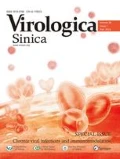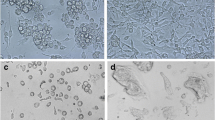Abstract
Lepidopteran heat-tolerant (ht) cell lines have been obtained with sf-9, sf-21 and several Bombyx cells. They have a distinct karyotype, membrane lipid composition, morphology and growth kinetics from the parental cell lines. In this paper, we report the development of ht cell lines from other insect species and examination of their growth characteristics and virus susceptibility. Adaptation of cell lines sf-9, BTI-TN-5B1-4 (High5) and BTI-TN-MG1 (MG1) to 33°C and 35°C was carried out by shifting the culture temperature between 28°C and higher temperatures by a gradual stepwise increase in temperature. The process of adaption to a higher culture temperature was accomplished over a period of 2 months. The cell lines with the temperature adaption were designated as sf9-ht33, sf9-ht35, High5-ht33, High5-ht35, MG1-ht33, MG1-ht35. These cell lines have been subcultured over 70 passages. Adaption to high temperatures was confirmed by a constant population doubling time with individual cell lines. The population doubling time of heat adapted cell lines were 1–4 h less than these of parental cell lines. Cell shapes did not show obvious change, however, the cell size of sf9-ht cells was enlarged and those of High5 and MG1 ht cells were reduced after heat adaption. When the cell lines were infected with Autographa californica nuclear polyhedrosis virus (AcMNPV) at 28°C, 33°C, 35°C and 37°C, production of budded virus and occlusion bodies in each cell line was optimum at its own adapted temperature.
Similar content being viewed by others
References
Carretero M T, Carmona M J, Diez J L. 1991. Thermotolerance and heat shock proteins in Chironomus. J Insect Physiol, 37: 239–246.
Carvalho M G, Freitas M S. 1988. Effect of continues heat stress on cell growth and protein synthesis in Aedes albopictus. J Cell Physiol, 137: 455–461.
Earley E M. 1975. Chromosomal preparation from monolayer cell cultures. Methods Cell Sci, 1: 31–35.
Fittinghoff C M, Riddiford L M. 1990. Heat sensitivity and protein synthesis during heat-shock in the tobacco hornworm, Manduca sexta. J Comp Physiol B, 160: 349–356.
Gerbal M, Fournier P, Barry P, et al. 2000. Adaptation of an insect cell line of Spodoptera frugiperda to grow at 37°C: characterization of an endodiploid clone. In Vitro Cell Dev Biol-Anim, 36: 117–124.
Grace T D C. 1962. Establishment of four strains of cells from insect tissues grown in vitro. Nature, 195: 788–789.
Grace T D C. 1967. Insect cell culture and virus research. In Vitro Cell Dev Biol — plant, 3: 104–117.
Granados R R, Li G, Blissard G W. 2007. Insect cell culture and biotechnology. Virol Sin, 22: 83–93.
Granados R R, Li G, Derksen A C G, et al. 1994. A new insect cell line from Trichoplusia ni (BTI-Tn-5B1-4) susceptible to Trichoplusia ni singly enveloped nuclear polyhedrosis virus. J Invertebr Pathol, 64: 260–266.
Hayflick L. 1973. Theory of population increase by subcultivation. In: Tissue Culture Methods and Application (Kruse P E & Patterrson M K. eds.), Pulishing place: Academic Press, New York. p222–223.
Imanishi S, Cho E S, Tomita S. 1999. Novel Bombyx mori cell lines cultivable at 37°C. Appl Entomol Zool, 34: 259–266.
Li G X, Hashimoto Y, Granados R R. 2003. Growth characteristics and expression of recombinant protein by new cell clones derived from Trichoplusia ni (BTI-Tn-5B1-4) High Five cells. Bioprocessing, 2: 34–37.
Lindquist S, Graig E A. 1988. The heat shock proteins. Annu Rev Genet, 22: 631–677.
Lynn D E. 2001. Effects of temperature on the susceptibility of insect cells to infection by baculovirus. Methods Cell Sci, 23: 221–225.
Meng M J, Li T L, Li C Y, et al. 2008. A suspended cell lines from Trichoplusia ni (Lepidoptera): Characterization and expression of recombinant proteins. Insect Sci, 15:423–428.
Mitchell H K, Moller G, Petersen N S. 1979. Specific protection from phenocopy induction by heat shock. Dev Genet, 1:181–192.
Ritossa F M. 1962. A new puffing pattern induced by heat shock and DNP in Drosophila. Experimentia, 18: 571–573.
Wang P, Granados R R, Shuler M L. 1992. Studies on serum-free culture of insect cells for virus propagation and recombinant protein production. J Invertebr Pathol, 59: 46–53.
Wang P, Toung R, Granados R R. 1999. The establishment of new cell lines from Pseudaletia unipuncta with differerntial responses to baculovirus infection. In Vitro Cell Dev Biol Animal, 35: 333–338.
Author information
Authors and Affiliations
Corresponding author
Additional information
Foundation items: Chinese National Basic Research Program (973) 2009CB118900; Chinese National Science Foundation Project (30771451); Boyce Thompson Institute for Plant Research Project (BTI-QAU 1-23-2007).
Rights and permissions
About this article
Cite this article
Wu, Yl., Jiang, L., Hashimoto, Y. et al. Establishment, growth kinetics, and susceptibility to AcMNPV of heat tolerant lepidopteran cell lines. Virol. Sin. 26, 198–205 (2011). https://doi.org/10.1007/s12250-011-3177-x
Received:
Accepted:
Published:
Issue Date:
DOI: https://doi.org/10.1007/s12250-011-3177-x




